This article needs to be updated.(November 2014) |
Tropical storm (39–73 mph, 63–118 km/h)
Category 1 (74–95 mph, 119–153 km/h)
Category 2 (96–110 mph, 154–177 km/h)
Category 3 (111–129 mph, 178–208 km/h)
Category 4 (130–156 mph, 209–251 km/h)
Category 5 (≥157 mph, ≥252 km/h)
Unknown
Early on 7 March 2014, the Fiji Meteorological Service reported that Tropical Disturbance 18F had developed about 685 km (425 mi) to the west of Nadi. [2] [3] The system was located within a marginally favourable environment for further development, which included low to moderate vertical wind shear and favourable sea surface temperatures. [2] [3] [4] Over the next two days the system moved towards the north-northwest and slowly consolidated, as atmospheric convection wrapped into the system's low level circulation centre, before RSMC Nadi reported during 9 March that the system had developed into a tropical depression. [4] [5] During that day the system further consolidated as it affected Vanuatu and moved towards the north-northeast, before the United States Joint Typhoon Warning Center initiated warnings and designated the depression as Tropical Cyclone 18P later that day. [6] RSMC Nadi subsequently named the system Lusi at around 23:00 UTC (11:00 FST), after it had developed into a category 1 tropical cyclone on the Australian tropical cyclone intensity scale. [7] [8]
Preparations and impact
Vanuatu
Late on 9 March, ahead of the depression being classified as a tropical cyclone and named Lusi, the Vanuatu Meteorology and Geo-Hazards Department issued tropical cyclone warnings for the Vanuatu provinces of Torba, Sanma, Penama and Malampa. [9] [10]
The cyclone killed 10 people and impacted as many as 20,000 people, especially in Torba, Sanma, Penama, Malampa and Shefa Provinces. Many low-lying areas were flooded and more than 40 structures were damaged or destroyed. All provinces of the country reported damage to agriculture. [1]
Fiji
On 11 March, a tropical cyclone alert was issued for parts of the Western Division, as Lusi approached the islands from the west. [11] During the next day gale warnings were issued for the Western Division before they were cancelled later that day, as the system turned towards the south sooner than had been expected. [12] [13] [14] As a result, Fiji was spared any direct effects from the cyclone, while the associated trough of low pressure affected the islands until 13 March. [15]
New Zealand
During 9 March, MetService started to warn that a tropical weather system might affect New Zealand by the end of that week. [16] [17]
Cyclone Lusi hit New Zealand shores on 13 March. In preparation for the event the New Zealand government advised people to fix loosened things (such as trampolines), and the Civil Defense team was put on alert. Winds reaching up to 130 km/h were expected to occur in the cities of Auckland, Whangārei and Hamilton, and the east coast of the North Island was put on high alert. Lusi brought severe winds as it moved southeast towards Wellington and the northern South Island in the evening of 15 March. On 16 March, the severe gale winds slightly weakened, and Lusi pushed away from New Zealand on 17 March.
Insured losses across the country amounted to NZ$4 million (US$3 million). [18]
Retirement
Due to the impacts caused by the storm, the name Lusi was retired and was later replaced by Louise.
See also
Related Research Articles

The 2007–08 South Pacific cyclone season was one of the least active South Pacific tropical cyclone seasons on record, with only four tropical cyclones occurring within the South Pacific basin to the east of 160°E. The season officially ran from November 1, 2007, until April 30, 2008, although the first cyclone, Tropical Depression 01F, developed on October 17. The most intense tropical cyclone of the season was Severe Tropical Cyclone Daman, which reached a minimum pressure of 925 hPa (27.32 inHg) as it affected Fiji. After the season had ended, the names Daman, Funa, and Gene were retired from the tropical cyclone naming lists.
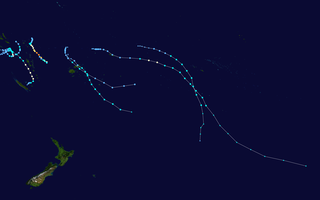
The 2006–07 South Pacific cyclone season was an event in the annual cycle of tropical cyclone formation. It began on November 1, 2006 and ended on April 30, 2007. These dates conventionally delimit the period of each year when most tropical cyclones form in the southern Pacific Ocean east of 160°E. Additionally, the regional tropical cyclone operational plan defines a tropical cyclone year separately from a tropical cyclone season, and the "tropical cyclone year" runs from July 1, 2006 to June 30, 2007.

The 2003–04 South Pacific cyclone season was a below-average season with only three tropical cyclones occurring within the South Pacific to the east of 160°E. The season officially ran from November 1, 2003 to April 30, 2004 with the first disturbance of the season forming on December 4 and the last disturbance dissipating on April 23. This is the period of the year when most tropical cyclones form within the South Pacific Ocean.

The 2007–08 South Pacific cyclone season was a below-average season with only four tropical cyclones, forming within the South Pacific to the east of 160°E. The season officially ran from November 1, 2007 to April 30, 2008, although the first cyclone, Tropical Depression 01F, formed on October 17.

The 2008–09 South Pacific cyclone season was a below average tropical cyclone season, which featured six named tropical cyclones compared to an average of about nine. Ahead of the season officially starting on November 1, 2008, the Island Climate Update tropical cyclone outlook predicted that the season, would feature an average risk of tropical cyclones impacting the South Pacific between 160°E and 120°W. The first tropical disturbance of the season developed to the northeast of the Samoan Islands on December 1, however, it remained weak and was last noted during the next day.

Severe Tropical Cyclone Funa was the second strongest tropical cyclone during the 2007–08 South Pacific cyclone season, causing heavy flood and wind damage to areas of Vanuatu. The third tropical cyclone and second severe tropical cyclone of the season to form to the west of 160°E, Funa formed from an area of disturbed weather within the monsoon trough northeast of Vanuatu on January 16, 2008. Steadily intensifying as it moved to the east and subsequently south, Funa reached peak intensity with 10-minute sustained winds of 175 km/h (110 mph). However, the cyclone encountered unfavorable conditions as it progressed further south, before transitioning into an extratropical cyclone on January 21.

The 2009–10 South Pacific cyclone season began on December 3, 2009 with the formation of Tropical Disturbance 01F, 32 days after the cyclone season had officially begun on November 1, 2009. The season ended on April 30, 2010. These dates conventionally delimit the period of each year when most tropical cyclones form in the southern Pacific Ocean east of 160°E. Additionally, the regional tropical cyclone operational plan defines a tropical cyclone year separately from a tropical cyclone season; the "tropical cyclone year" began on July 1, 2009 and ended on June 30, 2010. Tropical cyclones between 160°E and 120°W and north of 25°S are monitored by the Fiji Meteorological Service. Those that move south of 25°S are monitored by the Tropical Cyclone Warning Centre in Wellington, New Zealand. The first tropical disturbance of the season formed on December 3, about 1015 km (700 mi) to the north of Suva, Fiji and later intensified into Tropical Cyclone Mick. The last system, 15F, dissipated on April 5 of the following year.

This timeline documents all of the events of the 2009–10 South Pacific cyclone season which is the period that tropical cyclones formed in the southern Pacific Ocean. Within the Southern Pacific Ocean, most tropical cyclones form within the cyclone season which began on November 1 and will end on April 30, though occasionally cyclones form outside these times. The scope of this article is limited to tropical cyclones that form in the Indian Ocean 160°E and 120°W to the south of the equator. Should a tropical cyclone form to the west of 160°E then it will be monitored within the Australian region by the Australian Bureau of Meteorology, should a tropical cyclone form to the east of 120°W, it is unclear how it will be handled as no tropical cyclone has ever been observed in the South Pacific Ocean east of 120°W.
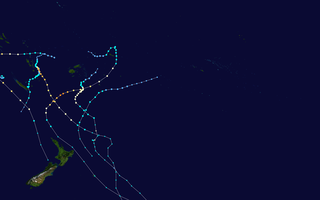
The 2010–11 South Pacific cyclone season was an average tropical cyclone season, with seven tropical cyclones and five severe tropical cyclones developing during the season. The season ran from November 1, 2010 until April 30, 2011, though if any tropical cyclones had developed between July 1, 2010 and June 30, 2011, the official tropical cyclone year, they would have been counted towards the season's total. Within the South Pacific basin tropical cyclones were officially monitored by the Fiji Meteorological Service's Regional Specialized Meteorological Center in Nadi, Fiji, north of 25°S, and to the south the Meteorological Service of New Zealand's Tropical Cyclone Warning Center in Wellington, New Zealand. Any disturbances forming in the region were designated with a sequential number suffixed by the letter F. In addition, the United States Military's Joint Typhoon Warning Center unofficially monitored parts of the basin during the season, where any systems judged to have achieved tropical storm strength or greater received a number suffixed with the letter P. RSMC Nadi and TCWC Wellington both use the Australian Tropical Cyclone Intensity Scale, and measure wind speeds over a period of ten minutes, while the JTWC measures sustained winds over a period of one minute which can be applied to the Saffir–Simpson hurricane scale. Seven named storms formed or moved into the South Pacific basin during the 2010–11 season, the strongest of which was Severe Tropical Cyclone Wilma in late January.

The 2011–12 South Pacific cyclone season was one of the least active South Pacific tropical cyclone seasons on record, with only three tropical cyclones occurring during the season. The season ran from November 1, 2011, to April 30, 2012, however, any tropical cyclones that form before June 30, 2012, would have fallen within the 2011–12 tropical cyclone year and would have counted towards the season total. The strongest and only severe tropical cyclone that occurred during the season was Severe Tropical Cyclone Jasmine, which tracked in from out of the South Pacific basin. Within the basin, tropical cyclones are monitored by the Regional Specialized Meteorological Center (RSMC) in Nadi, Fiji, and the Tropical Cyclone Warning Center (TCWC) in Wellington, New Zealand. RSMC Nadi attaches an F designation to tropical disturbances that form in or move into the South Pacific. The United States Joint Typhoon Warning Center (JTWC) issues unofficial warnings within the South Pacific, designating tropical storm-equivalent or greater tropical cyclones with a number and a P suffix. RSMC Nadi and TCWC Wellington both use the Australian Tropical Cyclone Intensity Scale, and measure windspeeds over a period of ten minutes, while the JTWC measures sustained winds over a period of one minute and uses the Saffir–Simpson hurricane scale.

The 2012–13 South Pacific cyclone season was a below average tropical cyclone season, with five tropical cyclones occurring within the basin between 160°E and 120°W. The season officially ran from November 1, 2012, to April 30, 2013, however the last tropical disturbance was last noted on May 1, as it moved into the subtropics. During the season, tropical cyclones were officially monitored by the Fiji Meteorological Service (FMS), Australian Bureau of Meteorology (BoM) and New Zealand's MetService. The United States Joint Typhoon Warning Center (JTWC) and other national meteorological services including Météo-France and NOAA also monitored the basin during the season. During the season there were 22 significant tropical disturbances assigned a number and a F suffix by the FMS's Regional Specialized Meteorological Center in Nadi, Fiji (RSMC Nadi), including Severe Tropical Cyclone Sandra which moved into the basin from the Australian region on March 9. The BoM, MetService and RSMC Nadi all estimated sustained wind speeds over a period of 10-minutes and used the Australian tropical cyclone intensity scale, while the JTWC estimated sustained winds over a 1-minute period, which are subsequently compared to the Saffir–Simpson hurricane wind scale (SSHS).
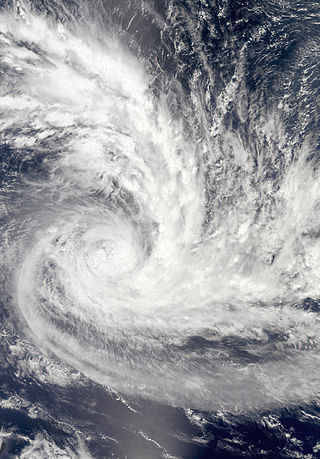
Tropical Cyclone Vania was the third depression and first tropical cyclone of the 2010–11 South Pacific cyclone season.

The 2013–14 South Pacific cyclone season was a slightly below average tropical cyclone season, with six tropical cyclones occurring within the basin between 160°E and 120°W. The season ran from November 1, 2013, to April 30, 2014, however, the first four tropical disturbances occurred during October 2013 and were included as a part of the season. During the season, tropical cyclones were officially monitored by the Fiji Meteorological Service (FMS), Australian Bureau of Meteorology (BoM) and New Zealand's MetService. The United States Joint Typhoon Warning Center (JTWC) and other national meteorological services including Météo-France and NOAA also monitored the basin during the season. During the season there were 21 significant tropical disturbances were assigned a number and an "F" suffix by the FMS's Regional Specialized Meteorological Center in Nadi, Fiji (RSMC Nadi), including the remnants of Tropical Cyclone Hadi from the Australian region. The BoM, MetService and RSMC Nadi all estimated sustained wind speeds over a period of 10-minutes and used the Australian tropical cyclone intensity scale, while the JTWC estimated sustained winds over a 1-minute period, which are subsequently compared to the Saffir–Simpson hurricane wind scale (SSHS).

The 2014–15 South Pacific cyclone season was a slightly-below average tropical cyclone season, with five tropical cyclones occurring within the basin between 160°E and 120°W. The season officially ran from November 1, 2014, to April 30, 2015. During the season, tropical cyclones were officially monitored by the Regional Specialized Meteorological Center (RSMC) in Nadi, Fiji and the Tropical Cyclone Warning Centers in Brisbane, Australia and Wellington, New Zealand. The United States Armed Forces through the Joint Typhoon Warning Center (JTWC) also monitored the basin and issued unofficial warnings for American interests. RSMC Nadi attaches a number and an F suffix to tropical disturbances that form in or move into the basin while the JTWC designates significant tropical cyclones with a number and a P suffix. RSMC Nadi, TCWC Wellington and TCWC Brisbane all use the Australian Tropical Cyclone Intensity Scale and estimate windspeeds over a period of ten minutes, while the JTWC estimated sustained winds over a 1-minute period, which are subsequently compared to the Saffir–Simpson hurricane wind scale (SSHWS).

The 2015–16 South Pacific cyclone season was one of the most disastrous South Pacific tropical cyclone seasons on record, with a total of 50 deaths and $1.405 billion in damage. Throughout the season, 8 systems attained tropical cyclone status, whilst 5 became severe tropical cyclones. The most notable cyclone of the season by far was Winston, which attained a minimum pressure of 884 hPa, and maximum ten-minute sustained winds of 175 mph (280 km/h), making it the most intense tropical cyclone on record in the Southern Hemisphere. Winston went on to devastate Fiji, causing $1.4 billion in damage and 44 deaths across the country.
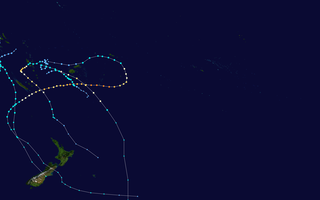
The 2017–18 South Pacific cyclone season was a slightly below-average season that produced 6 tropical cyclones, 3 of which became severe tropical cyclones. The season officially began on November 1, 2017, and ended on April 30, 2018; however, a tropical cyclone could form at any time between July 1, 2017, and June 30, 2018, and would count towards the season total. During the season, tropical cyclones were officially monitored by the Fiji Meteorological Service, MetService and the Australian Bureau of Meteorology, while the United States Joint Typhoon Warning Center (JTWC) also monitored the basin and issued warnings for American interests. The FMS attaches a number and an F suffix to significant tropical disturbances that form in or move into the basin, while the JTWC designates significant tropical cyclones with a number and a P suffix. The BoM, FMS and MetService all use the Australian Tropical Cyclone Intensity Scale and estimate wind speeds over a period of ten minutes, while the JTWC estimates sustained winds over a 1-minute period, which are subsequently compared to the Saffir–Simpson hurricane wind scale (SSHWS).

The 2018–19 South Pacific cyclone season was a below-average season that produced 5 tropical cyclones, 2 of which became severe tropical cyclones. The season officially runs from November 1, 2018, to April 30, 2019; however, a tropical cyclone could have formed at any time between July 1, 2018, and June 30, 2019, and would count towards the season total. During the season, tropical cyclones were officially monitored by the Fiji Meteorological Service, Australian Bureau of Meteorology, and New Zealand's MetService. The United States Armed Forces through the Joint Typhoon Warning Center (JTWC) also monitored the basin and issued warnings for American interests. RSMC Nadi attaches a number and an F suffix to tropical disturbances that form in or move into the basin, while the JTWC designates significant tropical cyclones with a number and a P suffix. The FMS, the BoM and MetService all use the Australian Tropical Cyclone Intensity Scale and estimate wind speeds over a period of ten minutes, while the JTWC estimates sustained winds over a 1-minute period, which are subsequently compared to the Saffir–Simpson hurricane wind scale (SSHWS).

Severe Tropical Cyclone Freda was an intense tropical cyclone that developed during the 2012–13 South Pacific cyclone season and affected New Caledonia and the Solomon Islands as a weak tropical cyclone. The system that was to become Cyclone Freda was first classified on 26 December 2012, as a tropical disturbance. It gradually developed and was classified as a tropical cyclone and named Freda as it passed through the Solomon Islands on 28 December.
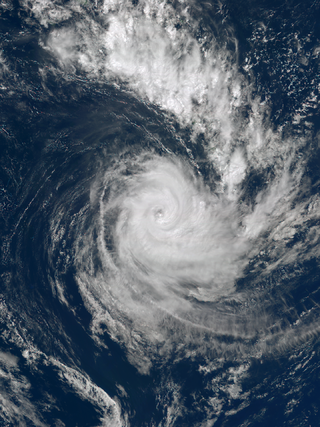
Severe Tropical Cyclone Cook was the second named tropical cyclone of the 2016–17 South Pacific cyclone season.

Severe Tropical Cyclone Donna was the strongest off-season tropical cyclone in the Southern Hemisphere at the time, since surpassed by Cyclone Lola in 2023. The twenty-first tropical disturbance, third named storm, and second severe tropical cyclone of the annual cyclone season, Donna formed from an area of disturbed weather that was first monitored west-northwest of Fiji on 1 May 2017. The disturbance drifted eastward amid an increasingly favourable environment, and it was designated Tropical Depression 21F late on 2 May. Twelve hours later, it intensified into a Category 1 on the Australian tropical cyclone scale and was designated Tropical Cyclone Donna as the storm's motion shifted west and then south. After reaching its initial peak as a Category 4 cyclone early on 6 May, the effects of wind shear and upwelling caused the storm to weaken. However, it reintensified into a Category 5 cyclone on 8 May. Soon after, Donna entered a region of strong westerly flow and began to rapidly weaken. Continuing to accelerate in a southerly direction, Donna eventually weakened into a tropical low on 10 May. By 16 May, Donna's remnants had fully dissipated.
References
- 1 2 "Asia Pacific Region: Weekly Regional Humanitarian Snapshot (11 - 17 March 2014) - Vanuatu".
- 1 2 RSMC Nadi – Tropical Cyclone Centre (7 March 2014). "Tropical Disturbance Summary March 7, 2014 09z". Fiji Meteorological Service. Archived from the original on 22 May 2024. Retrieved 10 October 2015.
- 1 2 Joint Typhoon Warning Center (7 March 2014). "Significant Tropical Weather Outlook for the Western and South Pacific Ocean March 7, 2014 06z". United States Navy, United States Airforce. Archived from the original on 22 May 2024. Retrieved 14 March 2014.
- 1 2 Joint Typhoon Warning Center (9 March 2014). "Significant Tropical Weather Outlook for the Western and South Pacific Ocean March 9, 2014 03z". United States Navy, United States Airforce. Archived from the original on 22 May 2024. Retrieved 14 March 2014.
- ↑ RSMC Nadi – Tropical Cyclone Centre (9 March 2014). "Tropical Disturbance Advisory March 9, 2014 06z". Fiji Meteorological Service. Archived from the original on 22 May 2024. Retrieved 9 March 2014.
- ↑ Joint Typhoon Warning Center (9 March 2014). "Tropical Cyclone 18P Warning 1 March 9, 2014 21z". United States Navy, United States Air Force. Archived from the original on 22 May 2024. Retrieved 14 March 2014.
- ↑ RSMC Nadi – Tropical Cyclone Centre (10 March 2014). "Tropical Disturbance Advisory March 10, 2014 00z". Fiji Meteorological Service. Archived from the original on 22 May 2024. Retrieved 16 March 2014.
- ↑ "Tropical Cyclone (TC) Lusi" (PDF) (Media Release). Fiji Meteorological Service. 10 March 2014. Archived from the original (PDF) on 16 March 2014. Retrieved 16 March 2014.
- ↑ "Tropical Cyclone Warning Number 1 for Torba, Sanma, Penama and Malampa Provinces". Vanuatu Meteorology and Geo-Hazards Department. 10 March 2014. Archived from the original on 22 May 2024. Retrieved 15 March 2014.
- ↑ "Tropical Cyclone Warning Number 2 for Torba, Sanma, Penama and Malampa Provinces". Vanuatu Meteorology and Geo-Hazards Department. 10 March 2014. Archived from the original on 22 May 2024. Retrieved 15 March 2014.
- ↑ RSMC Nadi – Tropical Cyclone Centre (11 March 2014). "Special Weather Bulletin Number 1 for Fiji on Tropical Cyclone Lusi, March 11, 2014 00z". Fiji Meteorological Service. Archived from the original on 22 May 2024. Retrieved 26 July 2014.
- ↑ RSMC Nadi – Tropical Cyclone Centre (12 March 2014). "Special Weather Bulletin Number 5 for Fiji on Tropical Cyclone Lusi, March 12, 2014 00z". Fiji Meteorological Service. Archived from the original on 22 May 2024. Retrieved 26 July 2014.
- ↑ RSMC Nadi – Tropical Cyclone Centre (12 March 2014). "Special Weather Bulletin Number 12 for Fiji on Tropical Cyclone Lusi, March 12, 2014 21z". Fiji Meteorological Service. Archived from the original on 22 May 2024. Retrieved 26 July 2014.
- ↑ "Fiji escapes effects of Cyclone Lusi as system turns south". Radio New Zealand. 13 March 2014. Archived from the original on 16 March 2014.
- ↑ Climate Services Division (9 April 2014). Fiji Climate Summary: January 2013 Volume 35: Issue 3 (PDF) (Report). Fiji Meteorological Service. Archived from the original (PDF) on 10 August 2014. Retrieved 26 July 2014.
- ↑ "Keeping an eye on the tropics" (MetService News Release). Meteorological Service of New Zealand Limited. 10 March 2014. Retrieved 17 March 2014.
- ↑ "Cyclone Lusi retreating to open waters". Meteorological Service of New Zealand Limited. 17 March 2014. Archived from the original on 17 March 2014. Retrieved 17 March 2014.
- ↑ "Half Year 2014 Insured Storm Damage Bill Nears $77 Million". Insurance Council of New Zealand. 9 July 2014. Archived from the original on 27 October 2017. Retrieved 25 April 2015.
External links
 Cyclone Lusi on March 12, 2014 |
| 1970s | |
|---|---|
| 1980s | |
| 1990s | |
| 2000s | |
| 2010s | |
| 2020s | |
